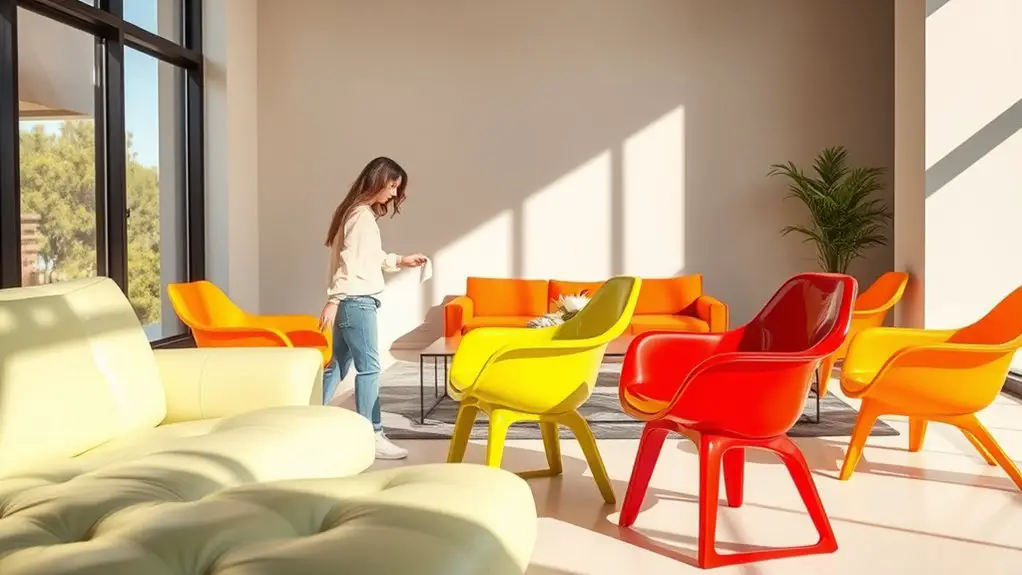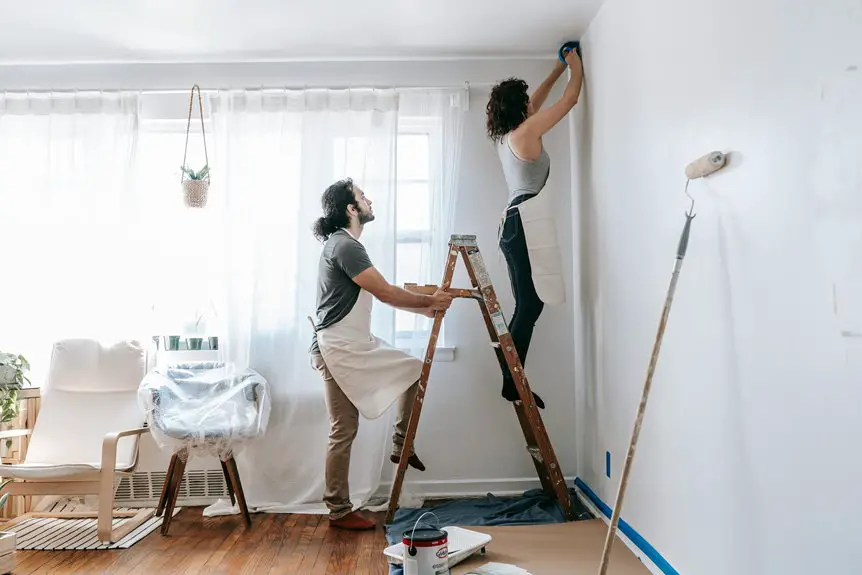Plastic furniture is a game-changer for modern design. It offers incredible durability, especially with materials like HDPE and polypropylene. These pieces resist impacts, fading, and stains, making them perfect for high-traffic areas. Plus, they're eco-friendly since recycled plastics help divert waste from landfills and oceans. Customization options, from colors to ergonomic designs, let you match your aesthetics effortlessly. Maintenance is a breeze, requiring just soap and water. And let's not forget the cost-effectiveness—less spending on materials and upkeep! Discover even more insights that can elevate your design choices.
Key Takeaways
- Designers appreciate plastic furniture for its durability, as materials like HDPE resist impacts and extreme weather, ensuring longevity in various settings.
- The versatility of plastic furniture allows for extensive customization in color, design, and finishes, enhancing the aesthetic appeal of any space.
- Eco-conscious designers favor recycled plastics, which reduce landfill waste and conserve natural resources while saving significant energy compared to new plastic production.
- The low maintenance requirements of plastic furniture make it practical for busy environments, needing only mild soap and water for cleaning.
- Cost-effective sourcing from post-consumer waste allows designers to create sustainable spaces while managing operating costs efficiently.
Sustainability and Environmental Benefits
Recognizing the impact of plastic furniture on the environment, many designers are embracing sustainability and its numerous benefits. By incorporating recycled materials into their creations, you can help reduce landfill waste and pollution. Did you know that around 9 million tons of furniture waste ends up in landfills each year? Using recycled plastics diverts these materials from landfills and oceans, addressing a significant environmental concern. This practice is especially effective when using high-density polyethylene (HDPE), which is highly durable and resistant to rot.
Moreover, crafting furniture from recycled materials conserves natural resources, minimizing the need for new resource exploitation. Unlike traditional manufacturing, which often leads to resource destruction, recycling repurposes materials that would otherwise be discarded. This practice also plays a crucial role in reducing deforestation, a major contributor to climate change. Additionally, by using recycled plastics, you are contributing to a circular economy, where products are designed for longevity and reuse.
Additionally, recycling plastics saves approximately 70% of the energy required to create new plastic. That means a lower carbon footprint for your furniture and a smaller impact on our planet. By choosing recycled plastic furniture, you align with sustainable practices that promote a circular economy, where products are designed for longevity and reuse.
Durability and Longevity Advantages
Plastic furniture offers impressive durability and longevity advantages that make it an ideal choice for both indoor and outdoor settings. Made from high-density polyethylene (HDPE) or polypropylene, these materials are incredibly strong and resilient. They resist impacts, ensuring that cracks and splinters are virtually nonexistent, even in high-traffic areas. You can confidently use plastic furniture daily without worrying about chips, breaks, or degradation over time.
Weather resistance is another standout feature. Plastic furniture can withstand extreme conditions like sun, rain, and cold without fading or warping. The UV-resistant materials prevent damage from prolonged sun exposure, maintaining both appearance and functionality for years in outdoor environments. Additionally, these materials offer impressive weather resistance, making them suitable for use in challenging climates.
Low maintenance is a significant benefit too. Unlike wood or metal, plastic doesn't rust, rot, or require special treatments. Cleaning is a breeze—just use warm soapy water to keep your furniture in top condition.
Plus, the non-porous surface makes it resistant to stains and scratches, ensuring longevity even in homes with kids.
Cost-Effectiveness for Businesses

Finding cost-effectiveness in furniture choices can significantly impact a business's bottom line, especially when considering recycled plastic furniture. Recycled plastic materials typically account for 40-50% of total operating costs, with raw material costs ranging from $1.50 to $2.50 per pound.
By sourcing materials from post-consumer waste or industrial scrap, you can secure a reliable and cost-effective supply, which is crucial for managing your production expenses. Additionally, monitoring utility expenses is essential for maintaining profitability in the recycled plastic market.
Manufacturing costs also play a vital role. Energy consumption and labor account for substantial portions of your overall expenses, but investing in recycled plastic can yield lower long-term maintenance costs. The resilience of this furniture against environmental factors means fewer replacements, potentially saving you around 30% over ten years.
Leasing manufacturing facilities can further enhance your savings. Negotiating favorable lease terms or opting for shared spaces can reduce monthly rental costs. Plus, bulk purchasing for large-scale needs can provide significant discounts.
Design Flexibility and Customization
Design flexibility and customization in furniture can transform any space, offering you the chance to tailor pieces to your unique style and functional needs.
With plastic furniture, you can explore a wide array of options that not only enhance aesthetics but also ensure comfort and utility. The rise of plastic chairs in wholesale markets has further driven innovation and variety in customization options available to consumers.
Here are some key customization features you can consider:
- Color Customization: Choose from a vibrant spectrum to match your décor or personal taste.
- Ergonomic Designs: Opt for features that enhance comfort, catering to your specific ergonomic needs.
- Unique Finishes: Select from various finishes that elevate the visual appeal of your plastic furniture.
- Branding Integration: Perfect for businesses, you can incorporate your logo and colors for a cohesive brand identity.
- Event-Specific Customization: Tailor furniture to fit the theme of events, ensuring everything aligns perfectly.
The beauty of customization lies in its ability to cater to your exact requirements, whether you're designing a cozy home environment or creating a professional workspace.
Embracing these options lets you make a lasting impression while meeting your functional needs effectively.
Practicality and Maintenance Ease

When you choose plastic furniture, you're not just opting for style; you're embracing practicality and ease of maintenance. Cleaning is simple—just use mild soap and water to avoid scratching the surface. A soft brush or cloth can help you remove dust and debris, while tougher stains can be tackled with a vinegar and baking soda mix. Always test a small area before applying any cleaner to protect the finish. To safeguard your furniture, cover it or move it indoors during extreme weather. Using furniture covers helps shield against dust and moisture, especially during off-seasons. Regularly check for loose screws to maintain structural integrity, and use epoxy glue for any cracks you find. Additionally, choosing high-quality materials ensures durability against outdoor conditions that can significantly extend the lifespan of your plastic furniture. If you're looking to refresh the appearance, consider repainting with outdoor-grade spray paint. When storing, opt for a dry, sheltered area to prevent cracking. Remember to avoid harsh waxes or polishes, as these can damage the plastic.
Frequently Asked Questions
How Does Plastic Furniture Compare to Traditional Materials in Terms of Aesthetics?
When you compare plastic furniture to traditional materials, you'll notice plastic often lacks elegance and sophistication. However, it offers versatility in design and colors, while traditional pieces provide timeless charm and natural beauty that many appreciate.
What Are the Best Practices for Recycling Plastic Furniture?
To recycle plastic furniture effectively, sort it by plastic type, clean it thoroughly, and remove any non-plastic parts. Utilize local recycling programs or community drop-off centers to ensure responsible disposal and promote sustainability.
Are There Health Concerns Associated With Plastic Furniture?
Yes, there're health concerns with plastic furniture. Chemicals like formaldehyde and phthalates can irritate and disrupt your body's systems. Prolonged exposure may lead to serious health issues, so it's wise to choose products carefully.
Can Plastic Furniture Be Repaired if Damaged?
Yes, you can repair plastic furniture if damaged. Assess the damage, remove broken parts, and replace them with matching materials. Use glue or epoxy for secure bonding, then finish with paint for a cohesive look.
How Does Weather Affect the Color of Plastic Furniture Over Time?
Weather affects plastic furniture color significantly over time. Sunlight fades colors, humidity causes yellowing, and rain leads to mold growth. Extreme temperatures can warp or crack your furniture, altering its appearance and durability.

